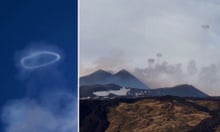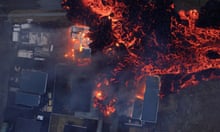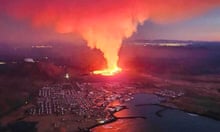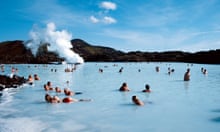Defensive barriers that were bolstered overnight around the fishing town of Grindavik appeared to have held, but a steadily slowing lava flow from the fourth volcanic eruption on Iceland’s Reykjanes peninsula since December remained a threat on Sunday.
After weeks of warnings that semi-molten rock was building up under the ground, the Icelandic Meteorological Office (IMO) said on Saturday night that the eruption, at 8.23pm local time (2023 GMT), had opened a nearly 3km long fissure in the earth between two mountains.
Lava was flowing mainly south and south-east at a rate of about 1km an hour overnight and could reach the ocean, the IMO said. Defensive dykes and barriers were being reinforced to stop a “significantly wider” lava bed wrecking the main coastal road.
By midday on Sunday, scientists said flows appeared to be slowing but still posed a danger to infrastructure in and around Grindavik. “Seismic activity has decreased since the eruption began,” the IMO’s Pálmi Erlendsson told the broadcaster RÚV.
Halldór Geirsson, an associate professor at the Institute of Earth Sciences at the University of Iceland, told Reuters the eruption was “quite energetic, and there was a lot of material coming out – more than in the previous eruption”.
“Lava was flowing quite fast,” he said, but the rate seemed to be steadily slowing and most of the flow was going “east of the town, towards the sea, so it looks like the barriers are doing the job they were designed for”.
Einar Bessi Gestsson of Iceland’s meteorological agency told the broadcaster RÚV that dangerous gases could be released and small explosions could occur if the lava entered the sea in any large quantity.
Another IMO expert, Einar Hjörleifsson, confirmed the barriers erected around the town were holding and were redirecting flows away from key infrastructure, although a separate flow towards a geothermal power plant still posed a risk.

The Svartsengi power plant, which supplies electricity and water to about 30,000 people on the Reykjanes peninsula, was evacuated and has been run remotely since the first eruption in the region, and dykes have been built to protect it.
The eruption site is a few miles north-east of Grindavik, about 30 miles south-west of Iceland’s capital, Reykjavik. The town’s 3,800 inhabitants were evacuated before the first eruption in December and barely 100 had since returned.
Hundreds of people were evacuated on Saturday from the nearby Blue Lagoon thermal spa, one of Iceland’s most popular tourist attractions, RÚV reported, as footage showed smoke billowing and red-orange magma bubbling from the earth.
Magnús Tumi Guðmundsson, a geophysicist who flew over the site in a helicopter, told RÚV the latest eruption was the most powerful on the peninsula so far, with a longer fissure than in previous eruptions, and was “very active” on Saturday evening.
The few residents who had returned to their homes in Grindavik since the last eruption in February, which cut off heating to more than 20,000 people as lava flows destroyed roads and pipelines, were safely evacuated, officials said.
The town was first evacuated in November when the Svartsengi volcanic system awakened after almost 800 years with a series of earthquakes that opened large cracks in the ground north of the town, eventually erupting on 18 December.
On that occasion the town was spared, but a second eruption that began on 14 January sent lava towards it and several buildings were destroyed, although defensive walls bolstered after the first eruption stopped much of the flow.
A third eruption on 8 February lasted only hours but engulfed a key hot-water pipeline. None of the most recent Reykjanes eruptions have affected domestic or international flights from Iceland’s airports.
Iceland sits on a volcanic hotspot in the north Atlantic and is home to 33 active volcano systems. Authorities are highly experienced at dealing with frequent eruptions.
The most disruptive recent event was the 2010 eruption of the Eyjafjallajökull volcano, which led to widespread airspace closures over Europe.
Volcanic outbreaks in the Reykjanes peninsula are so-called fissure eruptions, which do not usually cause large explosions or significant dispersal of ash into the stratosphere.









